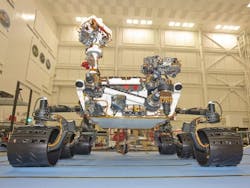3S Photonics’ laser diodes on their way to Mars
Nozay, France--Laser diodes made by 3S Photonics Group, a manufacturer of optical and optoelectronic components for telecommunications networks, are now en route to Mars as part of NASA’s Mars Science Laboratory (MSL) mission. Kicked off by a successful November 26 launch, the MSL aims to land and operate the Curiosity rover on the surface of Mars to find out if the Red Planet has ever been inhabited. The MSL is well-equipped with photonic instruments, including a number of cameras and a UV sensor.
CNES, the French Space Agency, in partnership with the Quantel group and the French Space Research Institute (CEST; Toulouse) designed and built two out of the ten instruments on board the Rover Curiosity, including the ChemCam (chemistry camera).
ChemCam analyzes the rocks and the ground up to 9 m away from the rover using laser-induced breakdown spectroscopy (LIBS). Laser pulses cause the material under test to melt and plasma to emerge, which is detected from a distance via UV-visible spectroscopy. Based on the information retrieved from ChemCam, the Rover can reposition itself near to any rock in order to carry out further analysis.
3S Photonics’ laser diodes were integrated into the ChemCam in 2004 and 2005.
